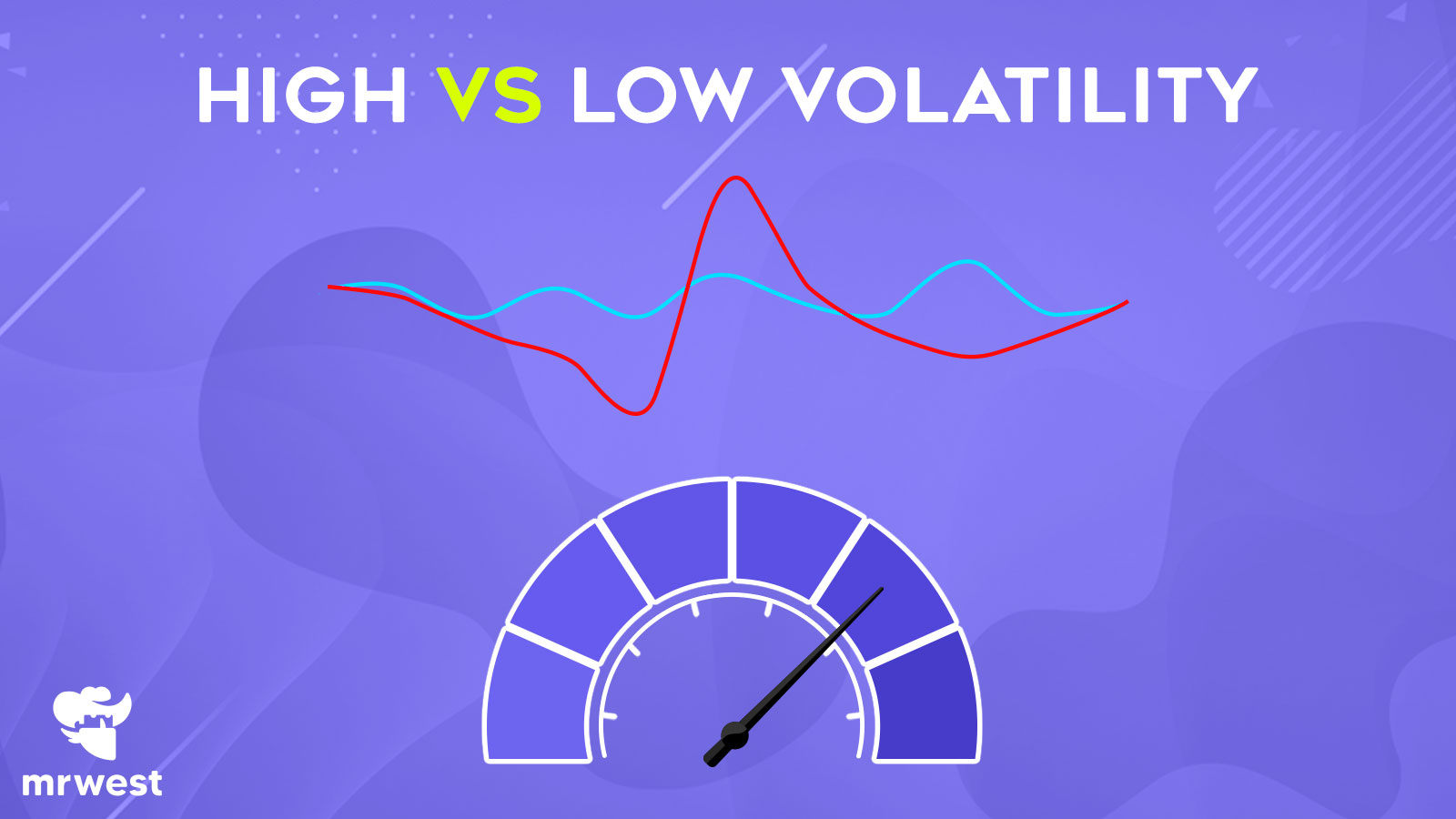When delving into slot games, you will come across terms such as RTP (Return to Player) and volatility, which are essential for grasping game mechanics. RTP signifies the percentage of wagered funds a slot game is set to pay back; for instance, in a game with a 95% RTP, you'd typically expect to lose $5 for every $100 wagered. However, this theoretical return rarely matches the outcome of individual gaming sessions, as RTP is calculated over a lengthy period and across many players.
The critical point isn't WHAT a slot pays out, but HOW it pays out– this is where high and low volatility comes into play.
What is Slot Volatility?
Slot volatility indicates a game’s hit frequency, or how often you will win over a set number of spins, and the payout size. It is one of the key characteristics of a game.
Things such as paylines and bonus features can affect the game's volatility. For instance, increasing the number of paylines (in a game that offers adjustable paylines) will result in more possible winning combinations, thus increasing the hit frequency.
Essentially, slot volatility determines the level of risk a player is exposed to during a game session.
What is the Difference Between Low and High Volatility?
The difference between low and high volatility lies in the frequency and size of payouts. Low volatility slots provide a steady stream of smaller wins, giving players a smoother and more reliable experience. On the other hand, high volatility slots provide less frequent but bigger payouts, making the gameplay more wild and unpredictable.
- High Volatility - High Risk/High Reward
- Medium Volatility - Average Risk/Average Reward
- Low Volatility - Low Risk/Low Reward
Is Volatility the Same as Variance?
Volatility and variance are often used interchangeably. Variance in slots refers to expected payout fluctuations over time. Volatility assesses the frequency and size of wins in a shorter timeframe. Simply put, variance is a longer-term application of volatility.
What is the Recommended Slot Volatility for New Players?
For newcomers to slot games, we recommend low to medium-volatility slots. These games are more forgiving to beginners, offering a smoother and less risky gameplay experience. Playing a lower-volatility game also enables players to acquaint themselves with the game's mechanics without facing crushing losses.
Contrary to popular belief, volatility does not impact RTP. Therefore, if you have a larger bankroll and are planning a longer gaming session, high-volatility slots are a suitable choice, even as a beginner.
How Can You Measure a Slot’s Volatility?
All slots operate according to a volatility index (VI) programmed during manufacture. While some slot VIs are available online (particularly from older games), most companies do not disclose their game VIs. So, while there is no way to measure a game’s volatility precisely, there are several indicators that you should look out for:
- Game Rules - More complex rules usually indicate higher volatility.
- Extra features, symbols, and bonus rounds - More choices for the RNG (random number generator) will result in higher volatility. Look out for symbols that pay double or triple.
- Higher Multipliers - Higher multipliers are often indicative of increased volatility.
- Paytable - Examine the paytable in-game. Higher rewards on the top line suggest higher volatility.
Additional online resources such as reviews, forum discussions, and analyses can also help you figure out a slot's volatility.
How Can You Tell if a Slot Machine is Low Volatility?
A low-volatility slot game typically has fewer features and more streamlined rules. You can always identify volatility by playing with low bets and keeping track of hit frequency. Low-volatility games are generally more straightforward and provide a less risky gaming experience.
Why is Understanding the Difference Between High and Low Volatility Important?
Knowing the difference between high and low volatility will help you choose a game that suits your playing style, risk tolerance, and bankroll. Volatility will influence your slot choice, bet sizing, strategy, and overall bankroll management.
What Should You Consider When Deciding Between High and Low Volatility Slots?
Several factors come into play when deciding between high and low volatility slots. First, consider your risk appetite. If you can stomach those dips in your bankroll while chasing a big win, go for high volatility. For some, increased variance can be psychologically draining, so we recommend the smoother experience of lower-volatility games.
Your gaming budget is another consideration. High volatility slots require a more substantial bankroll to endure potential dry spells between significant wins. This is especially true if you’re chasing a jackpot, so be prepared.
If you are trying to meet the wagering requirements of a bonus, look for a lower-volatility game. Always check your casino’s terms & conditions, as some games may not contribute 100% towards the wagering requirements. (Bonus Tip: The typical wagering requirement for bonuses is 35x to 50x)
The availability of slot machines will influence your decision. If you plan to visit a brick-and-mortar casino, note that most mechanical slots will be medium to high volatility. Opting for online play expands your choices significantly, although it's essential to be aware that most modern slot games lean towards high volatility. You will have to do some digging to find a low-volatility game.
What Kind of Gaming Experience Does High Volatility Offer?
High-volatility games have an element of anticipation and excitement as you’re working to pile up scatter symbols, unlock free spins or bonus features, and trigger expanding wilds. There’s always a chance to greatly multiply your bet and experience big wins. However, it’s important to recognize the trade-off - higher volatility always comes with the risk of eating your bankroll before you can get a return on bets. Many players enjoy the thrill of uncertainty and risk of highly volatile games.
What Does Low Volatility Offer in Terms of Gaming Experience?
Low volatility slots, in contrast, offer a more relaxed and predictable gaming experience. Players can expect a steady stream of smaller wins with a sense of consistency and continuity. This slot type is ideal for those who enjoy a more casual and less stressful gaming session. While the wins may be less substantial in proportion to your bet size, more frequent payouts reduce the risk of losing much of your bankroll.
Conclusion
Understanding slot volatility will shape your strategy and gaming experience. Deciding between high and low volatility is ultimately a matter of preference and risk tolerance, but knowing what you're getting into when you sit down to play a game is essential.
Responsible gaming advisory
Please note that the strategies and recommendations offered in our blog articles do not guarantee success or winnings. Gambling is inherently risky and should be undertaken with player discretion. MrWest holds no responsibility for any losses incurred by players while using these strategies and tips.
At MrWest, we are dedicated to endorsing responsible gaming as an integral part of our customer care and ethos. We aim for you to enjoy your casino experience while being fully aware of the risks of problem gambling. If you or someone you know is struggling with addictive gambling behaviors, please reach out:
- Gambling Therapy: https://www.gamblingtherapy.org/
- Gamblers Anonymous: http://www.gamblersanonymous.org/
- Responsible Gaming: http://www.responsiblegambling.org/
Resources
- QwertyLabs. (2022, December 23). Understandings slots volatility and RTP | The BC.Game Blog. Bc.game. https://blog.bc.game/understandings-slots-volatility-and-rtp/
- Cowboy Slots. (2022). What is Slot Machine Volatility? Why it matters when picking slots, how to use it [YouTube Video]. In YouTube. https://www.youtube.com/watch?v=4GiG7FLhV-w


